Kensington College: Business Strategy Report on J.P. Morgan (2019/20)
VerifiedAdded on 2023/01/12
|15
|4180
|87
Report
AI Summary
This report, prepared for Kensington College of Business's Business Strategy unit, analyzes the business strategy of J.P. Morgan, an American multinational financial services company. The report begins with an introduction to business strategy and then delves into an examination of the macro environment using PESTLE analysis, considering political, economic, social, technological, legal, and environmental factors impacting the company's operations. The internal environment is assessed using SWOT analysis, identifying J.P. Morgan's strengths, weaknesses, opportunities, and threats. Porter's Five Forces model is then applied to the financial services market, evaluating buyer power, supplier power, competitive rivalry, the threat of new entrants, and the threat of substitutes. Finally, the report concludes with a strategic plan, integrating the findings from the environmental and internal analyses to propose strategic directions for J.P. Morgan's growth and competitive positioning.
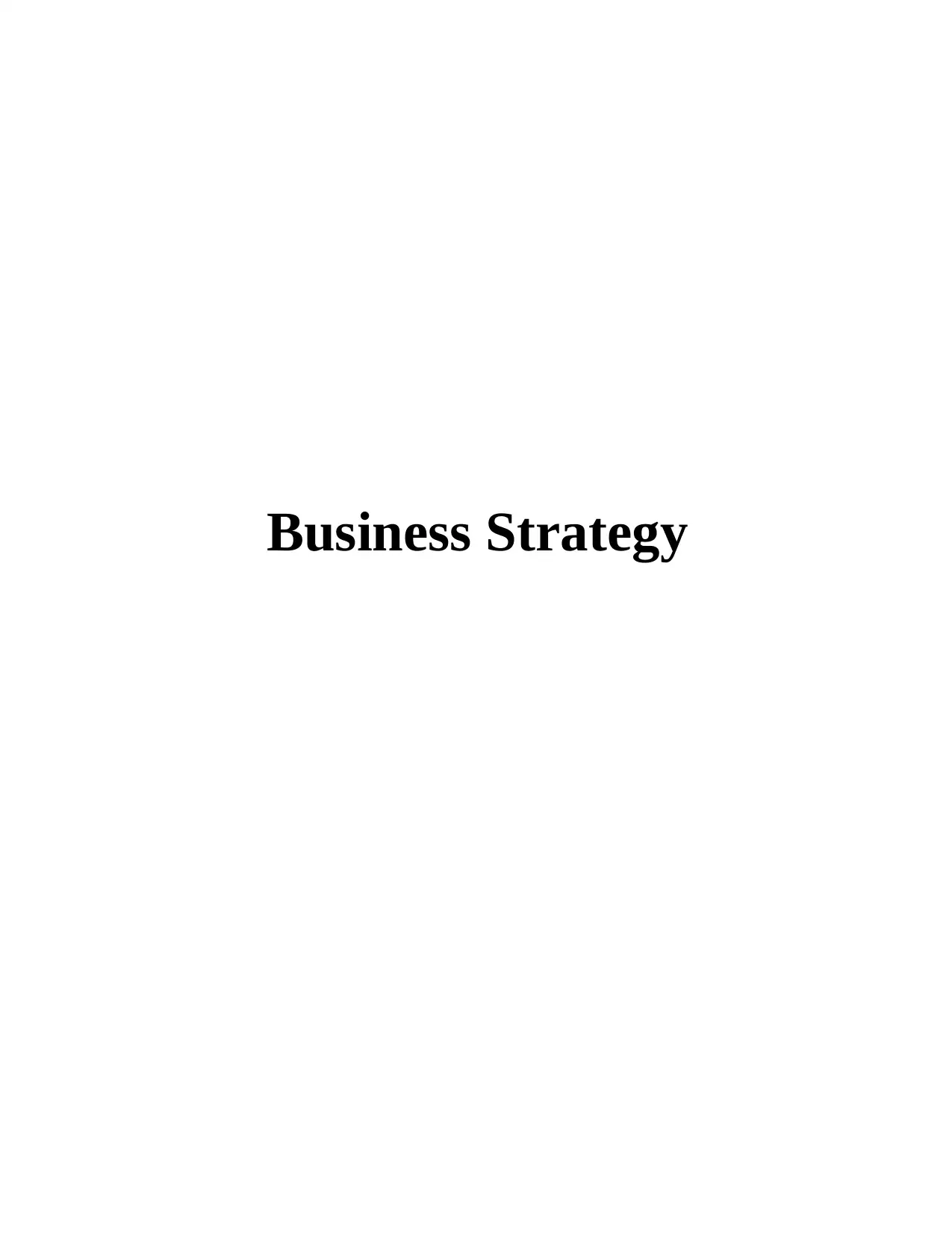
Business Strategy
Paraphrase This Document
Need a fresh take? Get an instant paraphrase of this document with our AI Paraphraser
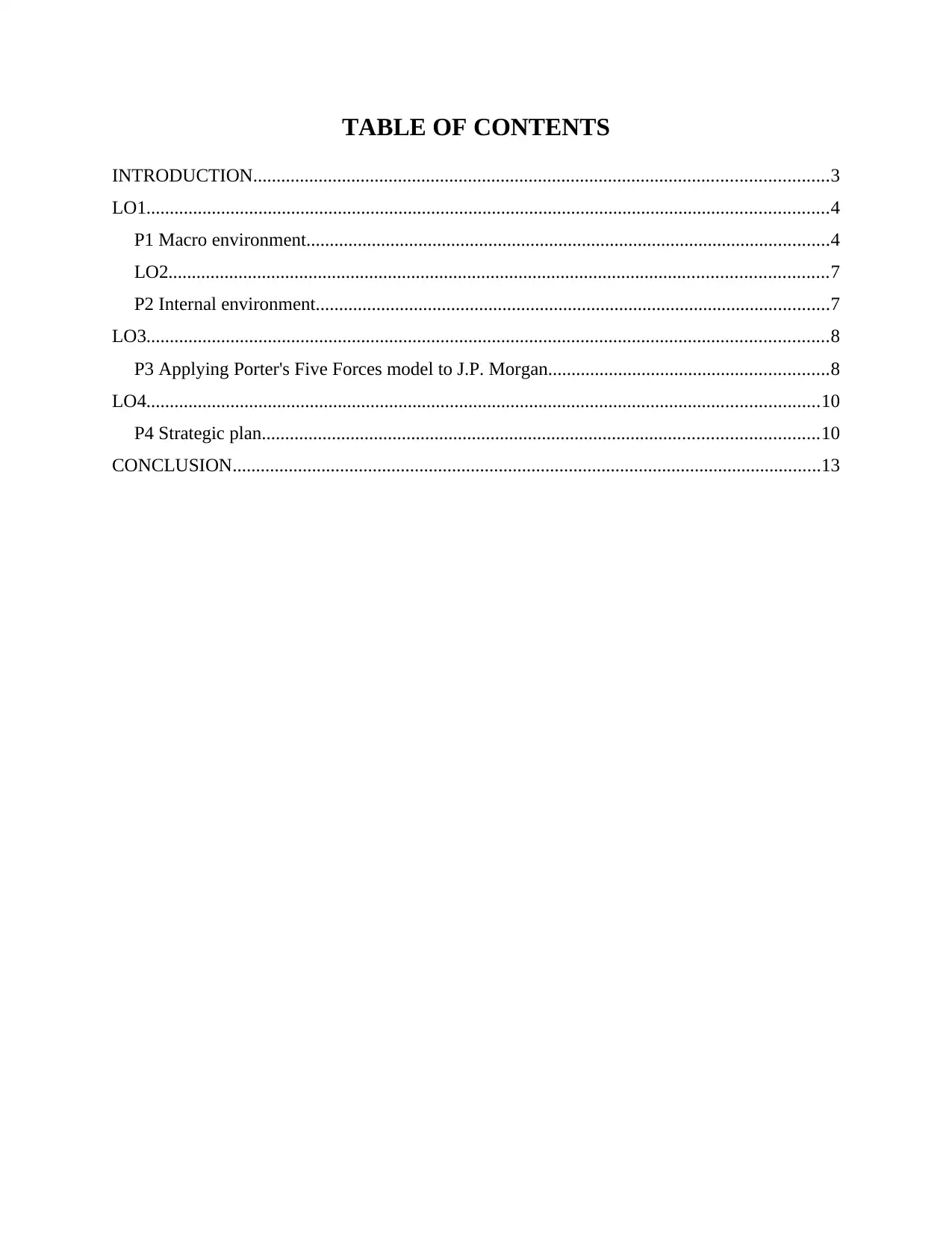
TABLE OF CONTENTS
INTRODUCTION...........................................................................................................................3
LO1..................................................................................................................................................4
P1 Macro environment................................................................................................................4
LO2.............................................................................................................................................7
P2 Internal environment..............................................................................................................7
LO3..................................................................................................................................................8
P3 Applying Porter's Five Forces model to J.P. Morgan............................................................8
LO4................................................................................................................................................10
P4 Strategic plan.......................................................................................................................10
CONCLUSION..............................................................................................................................13
INTRODUCTION...........................................................................................................................3
LO1..................................................................................................................................................4
P1 Macro environment................................................................................................................4
LO2.............................................................................................................................................7
P2 Internal environment..............................................................................................................7
LO3..................................................................................................................................................8
P3 Applying Porter's Five Forces model to J.P. Morgan............................................................8
LO4................................................................................................................................................10
P4 Strategic plan.......................................................................................................................10
CONCLUSION..............................................................................................................................13
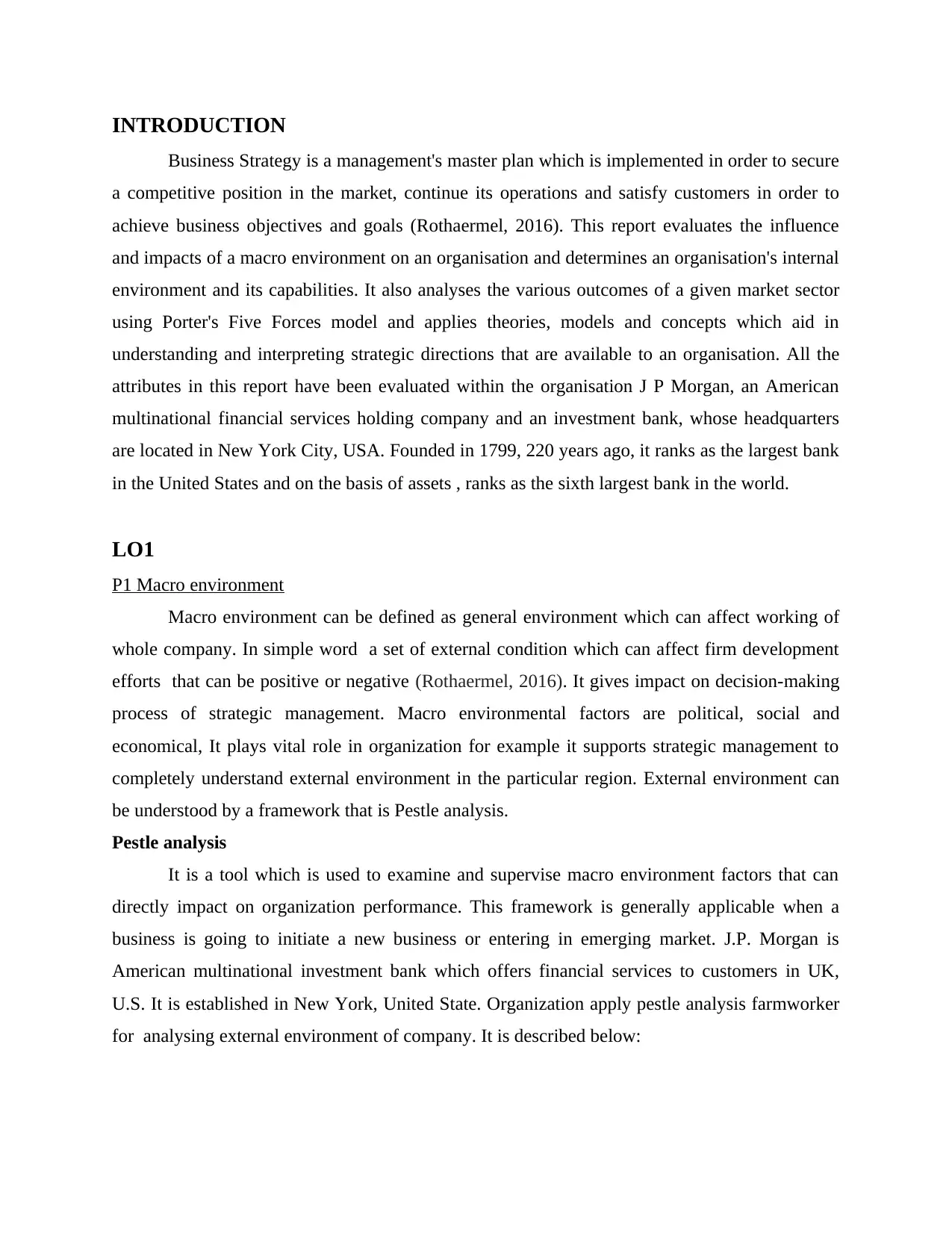
INTRODUCTION
Business Strategy is a management's master plan which is implemented in order to secure
a competitive position in the market, continue its operations and satisfy customers in order to
achieve business objectives and goals (Rothaermel, 2016). This report evaluates the influence
and impacts of a macro environment on an organisation and determines an organisation's internal
environment and its capabilities. It also analyses the various outcomes of a given market sector
using Porter's Five Forces model and applies theories, models and concepts which aid in
understanding and interpreting strategic directions that are available to an organisation. All the
attributes in this report have been evaluated within the organisation J P Morgan, an American
multinational financial services holding company and an investment bank, whose headquarters
are located in New York City, USA. Founded in 1799, 220 years ago, it ranks as the largest bank
in the United States and on the basis of assets , ranks as the sixth largest bank in the world.
LO1
P1 Macro environment
Macro environment can be defined as general environment which can affect working of
whole company. In simple word a set of external condition which can affect firm development
efforts that can be positive or negative (Rothaermel, 2016). It gives impact on decision-making
process of strategic management. Macro environmental factors are political, social and
economical, It plays vital role in organization for example it supports strategic management to
completely understand external environment in the particular region. External environment can
be understood by a framework that is Pestle analysis.
Pestle analysis
It is a tool which is used to examine and supervise macro environment factors that can
directly impact on organization performance. This framework is generally applicable when a
business is going to initiate a new business or entering in emerging market. J.P. Morgan is
American multinational investment bank which offers financial services to customers in UK,
U.S. It is established in New York, United State. Organization apply pestle analysis farmworker
for analysing external environment of company. It is described below:
Business Strategy is a management's master plan which is implemented in order to secure
a competitive position in the market, continue its operations and satisfy customers in order to
achieve business objectives and goals (Rothaermel, 2016). This report evaluates the influence
and impacts of a macro environment on an organisation and determines an organisation's internal
environment and its capabilities. It also analyses the various outcomes of a given market sector
using Porter's Five Forces model and applies theories, models and concepts which aid in
understanding and interpreting strategic directions that are available to an organisation. All the
attributes in this report have been evaluated within the organisation J P Morgan, an American
multinational financial services holding company and an investment bank, whose headquarters
are located in New York City, USA. Founded in 1799, 220 years ago, it ranks as the largest bank
in the United States and on the basis of assets , ranks as the sixth largest bank in the world.
LO1
P1 Macro environment
Macro environment can be defined as general environment which can affect working of
whole company. In simple word a set of external condition which can affect firm development
efforts that can be positive or negative (Rothaermel, 2016). It gives impact on decision-making
process of strategic management. Macro environmental factors are political, social and
economical, It plays vital role in organization for example it supports strategic management to
completely understand external environment in the particular region. External environment can
be understood by a framework that is Pestle analysis.
Pestle analysis
It is a tool which is used to examine and supervise macro environment factors that can
directly impact on organization performance. This framework is generally applicable when a
business is going to initiate a new business or entering in emerging market. J.P. Morgan is
American multinational investment bank which offers financial services to customers in UK,
U.S. It is established in New York, United State. Organization apply pestle analysis farmworker
for analysing external environment of company. It is described below:
⊘ This is a preview!⊘
Do you want full access?
Subscribe today to unlock all pages.

Trusted by 1+ million students worldwide
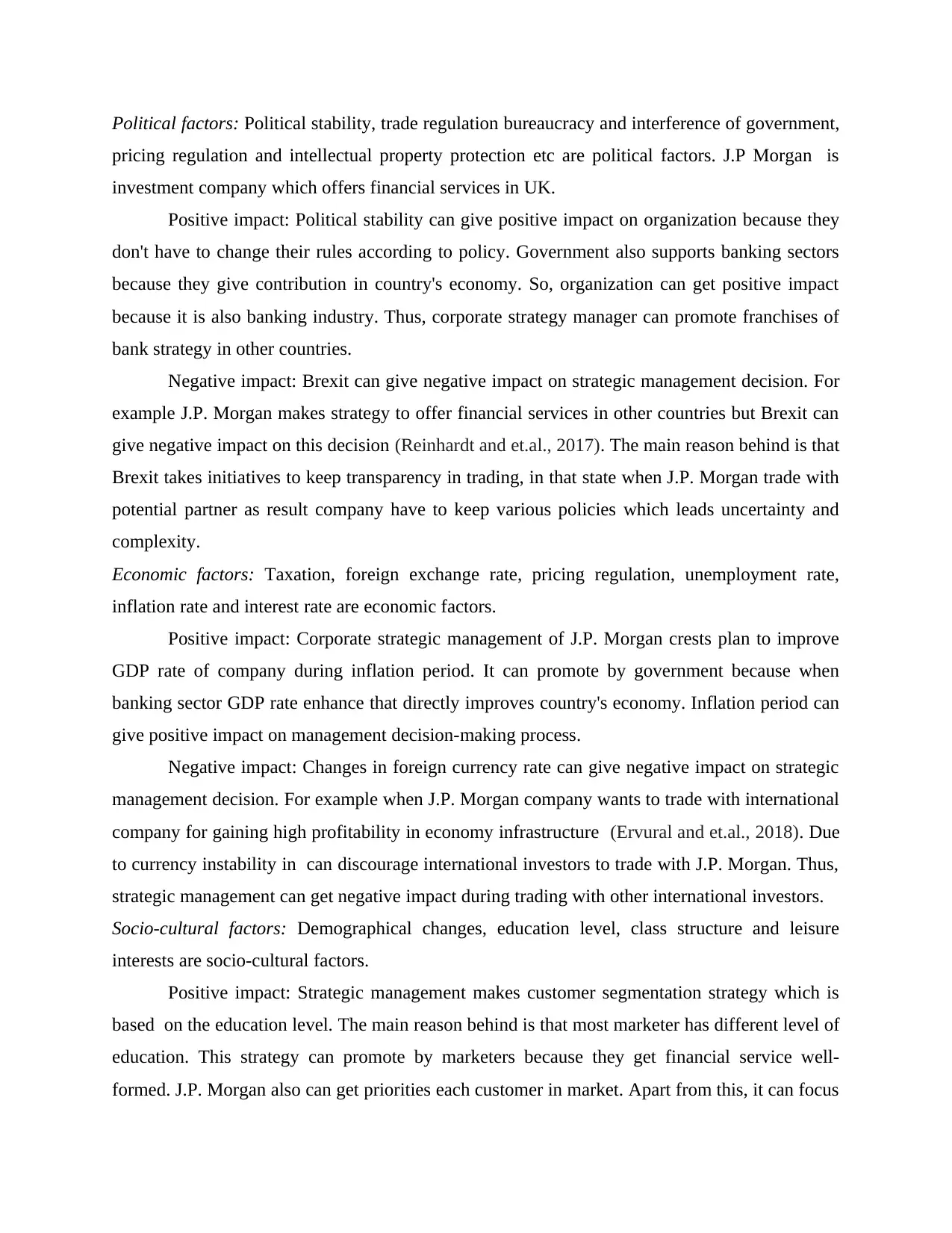
Political factors: Political stability, trade regulation bureaucracy and interference of government,
pricing regulation and intellectual property protection etc are political factors. J.P Morgan is
investment company which offers financial services in UK.
Positive impact: Political stability can give positive impact on organization because they
don't have to change their rules according to policy. Government also supports banking sectors
because they give contribution in country's economy. So, organization can get positive impact
because it is also banking industry. Thus, corporate strategy manager can promote franchises of
bank strategy in other countries.
Negative impact: Brexit can give negative impact on strategic management decision. For
example J.P. Morgan makes strategy to offer financial services in other countries but Brexit can
give negative impact on this decision (Reinhardt and et.al., 2017). The main reason behind is that
Brexit takes initiatives to keep transparency in trading, in that state when J.P. Morgan trade with
potential partner as result company have to keep various policies which leads uncertainty and
complexity.
Economic factors: Taxation, foreign exchange rate, pricing regulation, unemployment rate,
inflation rate and interest rate are economic factors.
Positive impact: Corporate strategic management of J.P. Morgan crests plan to improve
GDP rate of company during inflation period. It can promote by government because when
banking sector GDP rate enhance that directly improves country's economy. Inflation period can
give positive impact on management decision-making process.
Negative impact: Changes in foreign currency rate can give negative impact on strategic
management decision. For example when J.P. Morgan company wants to trade with international
company for gaining high profitability in economy infrastructure (Ervural and et.al., 2018). Due
to currency instability in can discourage international investors to trade with J.P. Morgan. Thus,
strategic management can get negative impact during trading with other international investors.
Socio-cultural factors: Demographical changes, education level, class structure and leisure
interests are socio-cultural factors.
Positive impact: Strategic management makes customer segmentation strategy which is
based on the education level. The main reason behind is that most marketer has different level of
education. This strategy can promote by marketers because they get financial service well-
formed. J.P. Morgan also can get priorities each customer in market. Apart from this, it can focus
pricing regulation and intellectual property protection etc are political factors. J.P Morgan is
investment company which offers financial services in UK.
Positive impact: Political stability can give positive impact on organization because they
don't have to change their rules according to policy. Government also supports banking sectors
because they give contribution in country's economy. So, organization can get positive impact
because it is also banking industry. Thus, corporate strategy manager can promote franchises of
bank strategy in other countries.
Negative impact: Brexit can give negative impact on strategic management decision. For
example J.P. Morgan makes strategy to offer financial services in other countries but Brexit can
give negative impact on this decision (Reinhardt and et.al., 2017). The main reason behind is that
Brexit takes initiatives to keep transparency in trading, in that state when J.P. Morgan trade with
potential partner as result company have to keep various policies which leads uncertainty and
complexity.
Economic factors: Taxation, foreign exchange rate, pricing regulation, unemployment rate,
inflation rate and interest rate are economic factors.
Positive impact: Corporate strategic management of J.P. Morgan crests plan to improve
GDP rate of company during inflation period. It can promote by government because when
banking sector GDP rate enhance that directly improves country's economy. Inflation period can
give positive impact on management decision-making process.
Negative impact: Changes in foreign currency rate can give negative impact on strategic
management decision. For example when J.P. Morgan company wants to trade with international
company for gaining high profitability in economy infrastructure (Ervural and et.al., 2018). Due
to currency instability in can discourage international investors to trade with J.P. Morgan. Thus,
strategic management can get negative impact during trading with other international investors.
Socio-cultural factors: Demographical changes, education level, class structure and leisure
interests are socio-cultural factors.
Positive impact: Strategic management makes customer segmentation strategy which is
based on the education level. The main reason behind is that most marketer has different level of
education. This strategy can promote by marketers because they get financial service well-
formed. J.P. Morgan also can get priorities each customer in market. Apart from this, it can focus
Paraphrase This Document
Need a fresh take? Get an instant paraphrase of this document with our AI Paraphraser
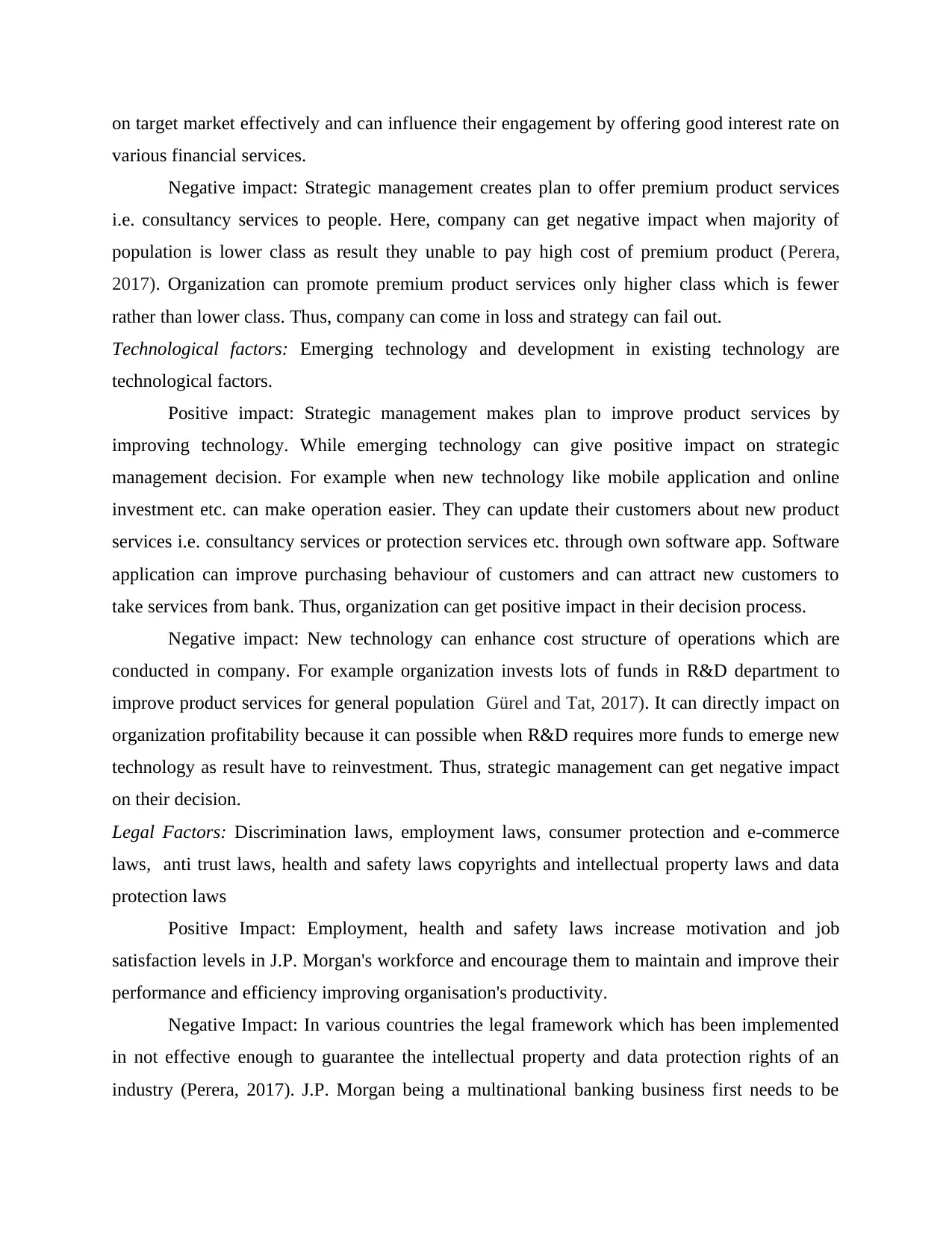
on target market effectively and can influence their engagement by offering good interest rate on
various financial services.
Negative impact: Strategic management creates plan to offer premium product services
i.e. consultancy services to people. Here, company can get negative impact when majority of
population is lower class as result they unable to pay high cost of premium product (Perera,
2017). Organization can promote premium product services only higher class which is fewer
rather than lower class. Thus, company can come in loss and strategy can fail out.
Technological factors: Emerging technology and development in existing technology are
technological factors.
Positive impact: Strategic management makes plan to improve product services by
improving technology. While emerging technology can give positive impact on strategic
management decision. For example when new technology like mobile application and online
investment etc. can make operation easier. They can update their customers about new product
services i.e. consultancy services or protection services etc. through own software app. Software
application can improve purchasing behaviour of customers and can attract new customers to
take services from bank. Thus, organization can get positive impact in their decision process.
Negative impact: New technology can enhance cost structure of operations which are
conducted in company. For example organization invests lots of funds in R&D department to
improve product services for general population Gürel and Tat, 2017). It can directly impact on
organization profitability because it can possible when R&D requires more funds to emerge new
technology as result have to reinvestment. Thus, strategic management can get negative impact
on their decision.
Legal Factors: Discrimination laws, employment laws, consumer protection and e-commerce
laws, anti trust laws, health and safety laws copyrights and intellectual property laws and data
protection laws
Positive Impact: Employment, health and safety laws increase motivation and job
satisfaction levels in J.P. Morgan's workforce and encourage them to maintain and improve their
performance and efficiency improving organisation's productivity.
Negative Impact: In various countries the legal framework which has been implemented
in not effective enough to guarantee the intellectual property and data protection rights of an
industry (Perera, 2017). J.P. Morgan being a multinational banking business first needs to be
various financial services.
Negative impact: Strategic management creates plan to offer premium product services
i.e. consultancy services to people. Here, company can get negative impact when majority of
population is lower class as result they unable to pay high cost of premium product (Perera,
2017). Organization can promote premium product services only higher class which is fewer
rather than lower class. Thus, company can come in loss and strategy can fail out.
Technological factors: Emerging technology and development in existing technology are
technological factors.
Positive impact: Strategic management makes plan to improve product services by
improving technology. While emerging technology can give positive impact on strategic
management decision. For example when new technology like mobile application and online
investment etc. can make operation easier. They can update their customers about new product
services i.e. consultancy services or protection services etc. through own software app. Software
application can improve purchasing behaviour of customers and can attract new customers to
take services from bank. Thus, organization can get positive impact in their decision process.
Negative impact: New technology can enhance cost structure of operations which are
conducted in company. For example organization invests lots of funds in R&D department to
improve product services for general population Gürel and Tat, 2017). It can directly impact on
organization profitability because it can possible when R&D requires more funds to emerge new
technology as result have to reinvestment. Thus, strategic management can get negative impact
on their decision.
Legal Factors: Discrimination laws, employment laws, consumer protection and e-commerce
laws, anti trust laws, health and safety laws copyrights and intellectual property laws and data
protection laws
Positive Impact: Employment, health and safety laws increase motivation and job
satisfaction levels in J.P. Morgan's workforce and encourage them to maintain and improve their
performance and efficiency improving organisation's productivity.
Negative Impact: In various countries the legal framework which has been implemented
in not effective enough to guarantee the intellectual property and data protection rights of an
industry (Perera, 2017). J.P. Morgan being a multinational banking business first needs to be
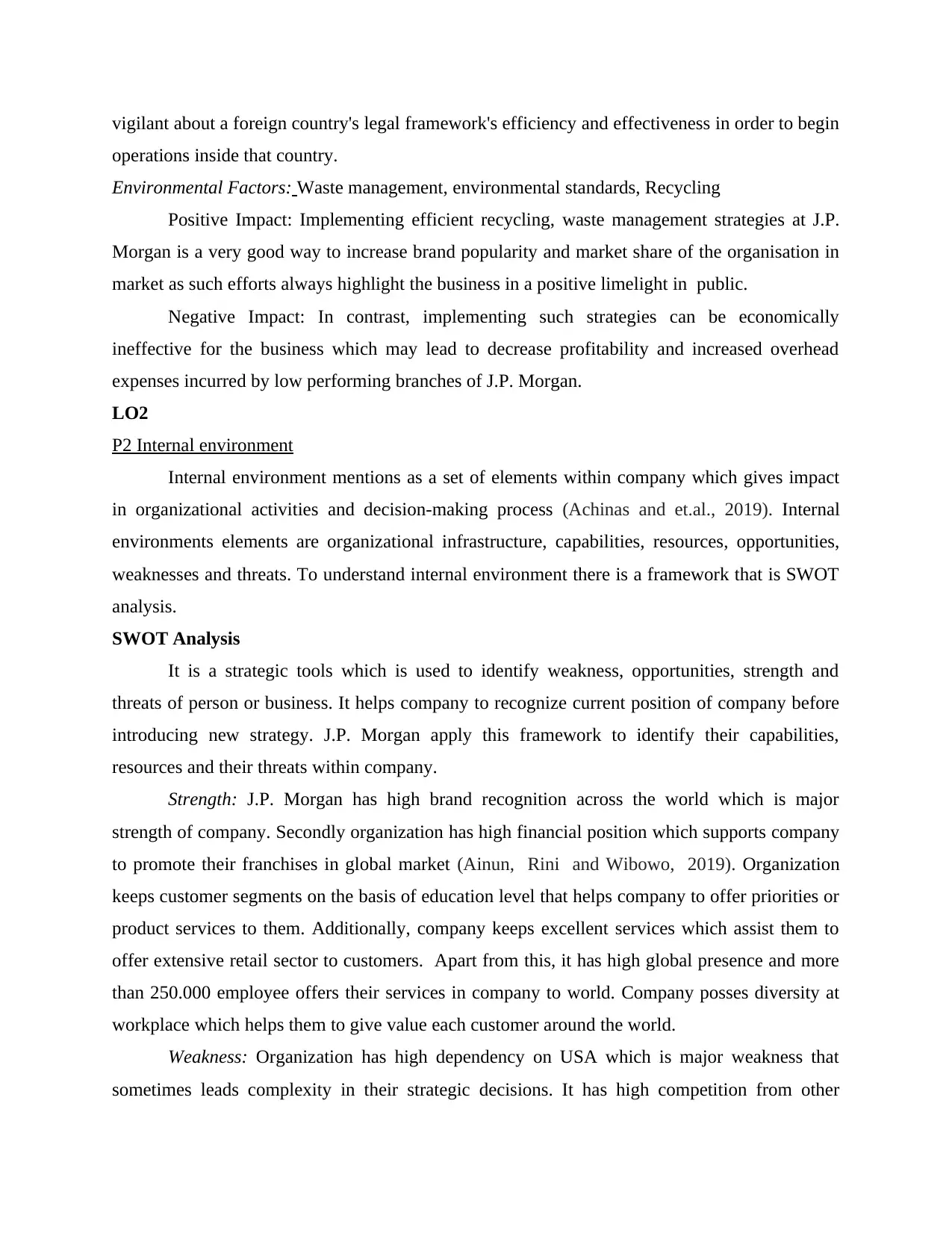
vigilant about a foreign country's legal framework's efficiency and effectiveness in order to begin
operations inside that country.
Environmental Factors: Waste management, environmental standards, Recycling
Positive Impact: Implementing efficient recycling, waste management strategies at J.P.
Morgan is a very good way to increase brand popularity and market share of the organisation in
market as such efforts always highlight the business in a positive limelight in public.
Negative Impact: In contrast, implementing such strategies can be economically
ineffective for the business which may lead to decrease profitability and increased overhead
expenses incurred by low performing branches of J.P. Morgan.
LO2
P2 Internal environment
Internal environment mentions as a set of elements within company which gives impact
in organizational activities and decision-making process (Achinas and et.al., 2019). Internal
environments elements are organizational infrastructure, capabilities, resources, opportunities,
weaknesses and threats. To understand internal environment there is a framework that is SWOT
analysis.
SWOT Analysis
It is a strategic tools which is used to identify weakness, opportunities, strength and
threats of person or business. It helps company to recognize current position of company before
introducing new strategy. J.P. Morgan apply this framework to identify their capabilities,
resources and their threats within company.
Strength: J.P. Morgan has high brand recognition across the world which is major
strength of company. Secondly organization has high financial position which supports company
to promote their franchises in global market (Ainun, Rini and Wibowo, 2019). Organization
keeps customer segments on the basis of education level that helps company to offer priorities or
product services to them. Additionally, company keeps excellent services which assist them to
offer extensive retail sector to customers. Apart from this, it has high global presence and more
than 250.000 employee offers their services in company to world. Company posses diversity at
workplace which helps them to give value each customer around the world.
Weakness: Organization has high dependency on USA which is major weakness that
sometimes leads complexity in their strategic decisions. It has high competition from other
operations inside that country.
Environmental Factors: Waste management, environmental standards, Recycling
Positive Impact: Implementing efficient recycling, waste management strategies at J.P.
Morgan is a very good way to increase brand popularity and market share of the organisation in
market as such efforts always highlight the business in a positive limelight in public.
Negative Impact: In contrast, implementing such strategies can be economically
ineffective for the business which may lead to decrease profitability and increased overhead
expenses incurred by low performing branches of J.P. Morgan.
LO2
P2 Internal environment
Internal environment mentions as a set of elements within company which gives impact
in organizational activities and decision-making process (Achinas and et.al., 2019). Internal
environments elements are organizational infrastructure, capabilities, resources, opportunities,
weaknesses and threats. To understand internal environment there is a framework that is SWOT
analysis.
SWOT Analysis
It is a strategic tools which is used to identify weakness, opportunities, strength and
threats of person or business. It helps company to recognize current position of company before
introducing new strategy. J.P. Morgan apply this framework to identify their capabilities,
resources and their threats within company.
Strength: J.P. Morgan has high brand recognition across the world which is major
strength of company. Secondly organization has high financial position which supports company
to promote their franchises in global market (Ainun, Rini and Wibowo, 2019). Organization
keeps customer segments on the basis of education level that helps company to offer priorities or
product services to them. Additionally, company keeps excellent services which assist them to
offer extensive retail sector to customers. Apart from this, it has high global presence and more
than 250.000 employee offers their services in company to world. Company posses diversity at
workplace which helps them to give value each customer around the world.
Weakness: Organization has high dependency on USA which is major weakness that
sometimes leads complexity in their strategic decisions. It has high competition from other
⊘ This is a preview!⊘
Do you want full access?
Subscribe today to unlock all pages.

Trusted by 1+ million students worldwide
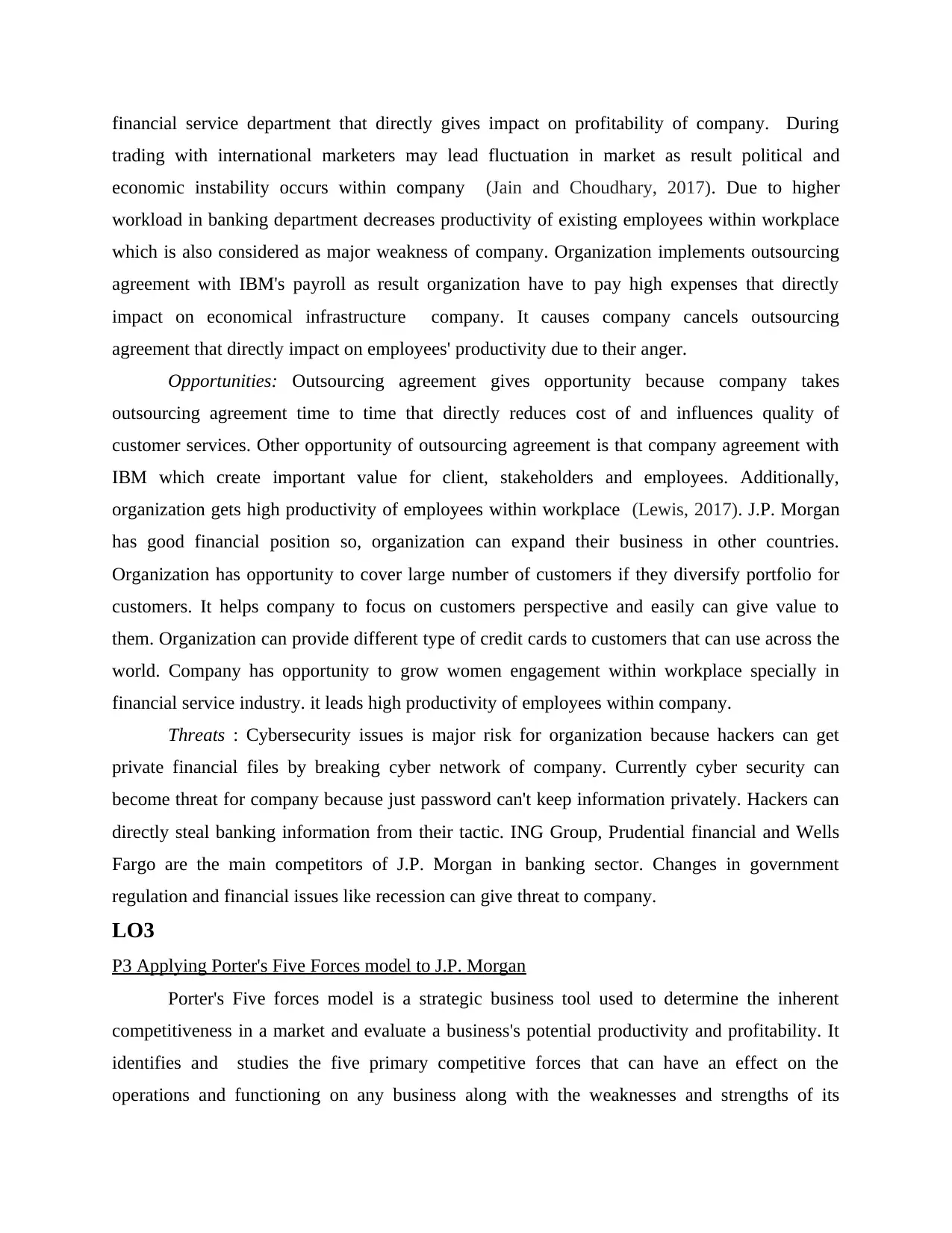
financial service department that directly gives impact on profitability of company. During
trading with international marketers may lead fluctuation in market as result political and
economic instability occurs within company (Jain and Choudhary, 2017). Due to higher
workload in banking department decreases productivity of existing employees within workplace
which is also considered as major weakness of company. Organization implements outsourcing
agreement with IBM's payroll as result organization have to pay high expenses that directly
impact on economical infrastructure company. It causes company cancels outsourcing
agreement that directly impact on employees' productivity due to their anger.
Opportunities: Outsourcing agreement gives opportunity because company takes
outsourcing agreement time to time that directly reduces cost of and influences quality of
customer services. Other opportunity of outsourcing agreement is that company agreement with
IBM which create important value for client, stakeholders and employees. Additionally,
organization gets high productivity of employees within workplace (Lewis, 2017). J.P. Morgan
has good financial position so, organization can expand their business in other countries.
Organization has opportunity to cover large number of customers if they diversify portfolio for
customers. It helps company to focus on customers perspective and easily can give value to
them. Organization can provide different type of credit cards to customers that can use across the
world. Company has opportunity to grow women engagement within workplace specially in
financial service industry. it leads high productivity of employees within company.
Threats : Cybersecurity issues is major risk for organization because hackers can get
private financial files by breaking cyber network of company. Currently cyber security can
become threat for company because just password can't keep information privately. Hackers can
directly steal banking information from their tactic. ING Group, Prudential financial and Wells
Fargo are the main competitors of J.P. Morgan in banking sector. Changes in government
regulation and financial issues like recession can give threat to company.
LO3
P3 Applying Porter's Five Forces model to J.P. Morgan
Porter's Five forces model is a strategic business tool used to determine the inherent
competitiveness in a market and evaluate a business's potential productivity and profitability. It
identifies and studies the five primary competitive forces that can have an effect on the
operations and functioning on any business along with the weaknesses and strengths of its
trading with international marketers may lead fluctuation in market as result political and
economic instability occurs within company (Jain and Choudhary, 2017). Due to higher
workload in banking department decreases productivity of existing employees within workplace
which is also considered as major weakness of company. Organization implements outsourcing
agreement with IBM's payroll as result organization have to pay high expenses that directly
impact on economical infrastructure company. It causes company cancels outsourcing
agreement that directly impact on employees' productivity due to their anger.
Opportunities: Outsourcing agreement gives opportunity because company takes
outsourcing agreement time to time that directly reduces cost of and influences quality of
customer services. Other opportunity of outsourcing agreement is that company agreement with
IBM which create important value for client, stakeholders and employees. Additionally,
organization gets high productivity of employees within workplace (Lewis, 2017). J.P. Morgan
has good financial position so, organization can expand their business in other countries.
Organization has opportunity to cover large number of customers if they diversify portfolio for
customers. It helps company to focus on customers perspective and easily can give value to
them. Organization can provide different type of credit cards to customers that can use across the
world. Company has opportunity to grow women engagement within workplace specially in
financial service industry. it leads high productivity of employees within company.
Threats : Cybersecurity issues is major risk for organization because hackers can get
private financial files by breaking cyber network of company. Currently cyber security can
become threat for company because just password can't keep information privately. Hackers can
directly steal banking information from their tactic. ING Group, Prudential financial and Wells
Fargo are the main competitors of J.P. Morgan in banking sector. Changes in government
regulation and financial issues like recession can give threat to company.
LO3
P3 Applying Porter's Five Forces model to J.P. Morgan
Porter's Five forces model is a strategic business tool used to determine the inherent
competitiveness in a market and evaluate a business's potential productivity and profitability. It
identifies and studies the five primary competitive forces that can have an effect on the
operations and functioning on any business along with the weaknesses and strengths of its
Paraphrase This Document
Need a fresh take? Get an instant paraphrase of this document with our AI Paraphraser
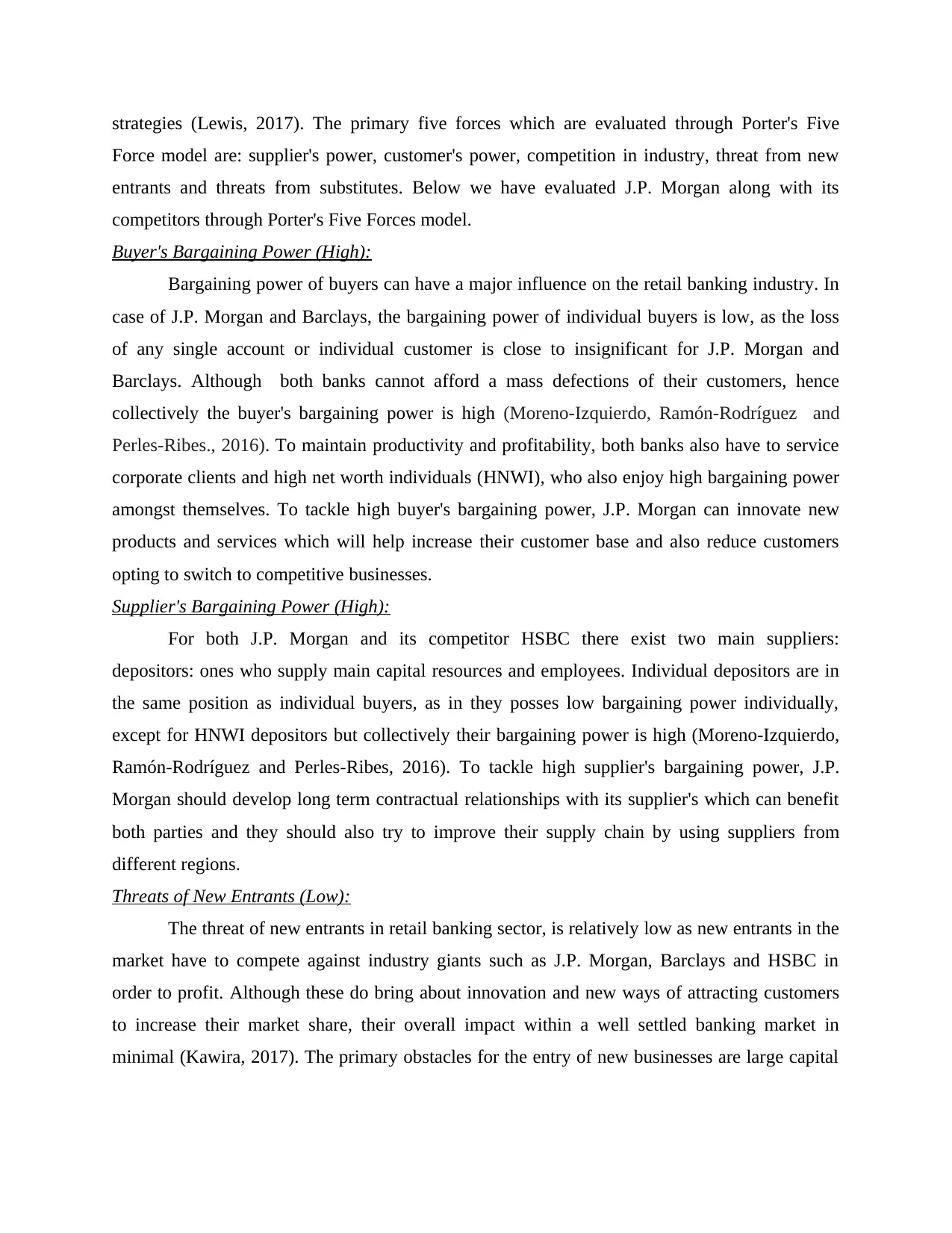
strategies (Lewis, 2017). The primary five forces which are evaluated through Porter's Five
Force model are: supplier's power, customer's power, competition in industry, threat from new
entrants and threats from substitutes. Below we have evaluated J.P. Morgan along with its
competitors through Porter's Five Forces model.
Buyer's Bargaining Power (High):
Bargaining power of buyers can have a major influence on the retail banking industry. In
case of J.P. Morgan and Barclays, the bargaining power of individual buyers is low, as the loss
of any single account or individual customer is close to insignificant for J.P. Morgan and
Barclays. Although both banks cannot afford a mass defections of their customers, hence
collectively the buyer's bargaining power is high (Moreno-Izquierdo, Ramón-Rodríguez and
Perles-Ribes., 2016). To maintain productivity and profitability, both banks also have to service
corporate clients and high net worth individuals (HNWI), who also enjoy high bargaining power
amongst themselves. To tackle high buyer's bargaining power, J.P. Morgan can innovate new
products and services which will help increase their customer base and also reduce customers
opting to switch to competitive businesses.
Supplier's Bargaining Power (High):
For both J.P. Morgan and its competitor HSBC there exist two main suppliers:
depositors: ones who supply main capital resources and employees. Individual depositors are in
the same position as individual buyers, as in they posses low bargaining power individually,
except for HNWI depositors but collectively their bargaining power is high (Moreno-Izquierdo,
Ramón-Rodríguez and Perles-Ribes, 2016). To tackle high supplier's bargaining power, J.P.
Morgan should develop long term contractual relationships with its supplier's which can benefit
both parties and they should also try to improve their supply chain by using suppliers from
different regions.
Threats of New Entrants (Low):
The threat of new entrants in retail banking sector, is relatively low as new entrants in the
market have to compete against industry giants such as J.P. Morgan, Barclays and HSBC in
order to profit. Although these do bring about innovation and new ways of attracting customers
to increase their market share, their overall impact within a well settled banking market in
minimal (Kawira, 2017). The primary obstacles for the entry of new businesses are large capital
Force model are: supplier's power, customer's power, competition in industry, threat from new
entrants and threats from substitutes. Below we have evaluated J.P. Morgan along with its
competitors through Porter's Five Forces model.
Buyer's Bargaining Power (High):
Bargaining power of buyers can have a major influence on the retail banking industry. In
case of J.P. Morgan and Barclays, the bargaining power of individual buyers is low, as the loss
of any single account or individual customer is close to insignificant for J.P. Morgan and
Barclays. Although both banks cannot afford a mass defections of their customers, hence
collectively the buyer's bargaining power is high (Moreno-Izquierdo, Ramón-Rodríguez and
Perles-Ribes., 2016). To maintain productivity and profitability, both banks also have to service
corporate clients and high net worth individuals (HNWI), who also enjoy high bargaining power
amongst themselves. To tackle high buyer's bargaining power, J.P. Morgan can innovate new
products and services which will help increase their customer base and also reduce customers
opting to switch to competitive businesses.
Supplier's Bargaining Power (High):
For both J.P. Morgan and its competitor HSBC there exist two main suppliers:
depositors: ones who supply main capital resources and employees. Individual depositors are in
the same position as individual buyers, as in they posses low bargaining power individually,
except for HNWI depositors but collectively their bargaining power is high (Moreno-Izquierdo,
Ramón-Rodríguez and Perles-Ribes, 2016). To tackle high supplier's bargaining power, J.P.
Morgan should develop long term contractual relationships with its supplier's which can benefit
both parties and they should also try to improve their supply chain by using suppliers from
different regions.
Threats of New Entrants (Low):
The threat of new entrants in retail banking sector, is relatively low as new entrants in the
market have to compete against industry giants such as J.P. Morgan, Barclays and HSBC in
order to profit. Although these do bring about innovation and new ways of attracting customers
to increase their market share, their overall impact within a well settled banking market in
minimal (Kawira, 2017). The primary obstacles for the entry of new businesses are large capital
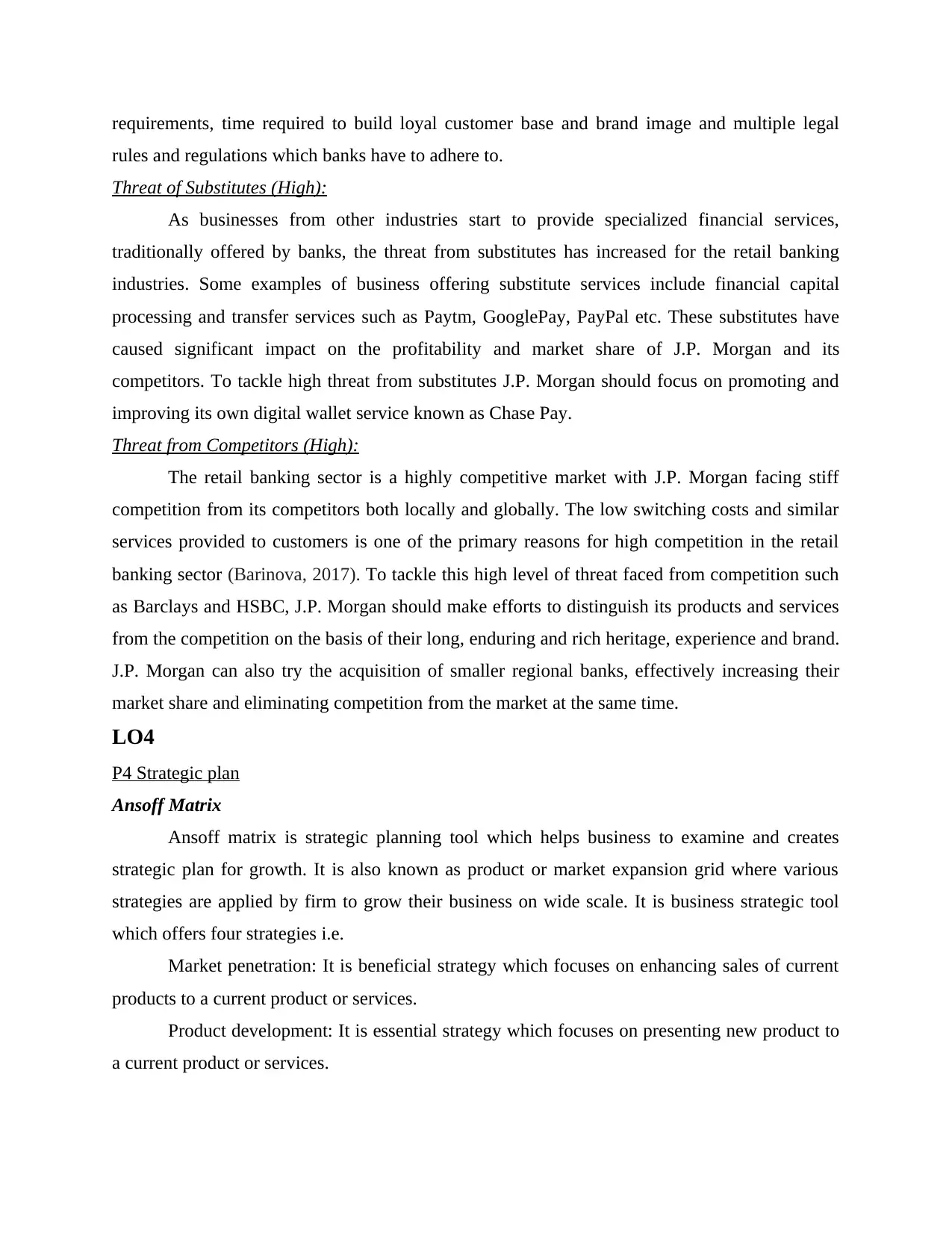
requirements, time required to build loyal customer base and brand image and multiple legal
rules and regulations which banks have to adhere to.
Threat of Substitutes (High):
As businesses from other industries start to provide specialized financial services,
traditionally offered by banks, the threat from substitutes has increased for the retail banking
industries. Some examples of business offering substitute services include financial capital
processing and transfer services such as Paytm, GooglePay, PayPal etc. These substitutes have
caused significant impact on the profitability and market share of J.P. Morgan and its
competitors. To tackle high threat from substitutes J.P. Morgan should focus on promoting and
improving its own digital wallet service known as Chase Pay.
Threat from Competitors (High):
The retail banking sector is a highly competitive market with J.P. Morgan facing stiff
competition from its competitors both locally and globally. The low switching costs and similar
services provided to customers is one of the primary reasons for high competition in the retail
banking sector (Barinova, 2017). To tackle this high level of threat faced from competition such
as Barclays and HSBC, J.P. Morgan should make efforts to distinguish its products and services
from the competition on the basis of their long, enduring and rich heritage, experience and brand.
J.P. Morgan can also try the acquisition of smaller regional banks, effectively increasing their
market share and eliminating competition from the market at the same time.
LO4
P4 Strategic plan
Ansoff Matrix
Ansoff matrix is strategic planning tool which helps business to examine and creates
strategic plan for growth. It is also known as product or market expansion grid where various
strategies are applied by firm to grow their business on wide scale. It is business strategic tool
which offers four strategies i.e.
Market penetration: It is beneficial strategy which focuses on enhancing sales of current
products to a current product or services.
Product development: It is essential strategy which focuses on presenting new product to
a current product or services.
rules and regulations which banks have to adhere to.
Threat of Substitutes (High):
As businesses from other industries start to provide specialized financial services,
traditionally offered by banks, the threat from substitutes has increased for the retail banking
industries. Some examples of business offering substitute services include financial capital
processing and transfer services such as Paytm, GooglePay, PayPal etc. These substitutes have
caused significant impact on the profitability and market share of J.P. Morgan and its
competitors. To tackle high threat from substitutes J.P. Morgan should focus on promoting and
improving its own digital wallet service known as Chase Pay.
Threat from Competitors (High):
The retail banking sector is a highly competitive market with J.P. Morgan facing stiff
competition from its competitors both locally and globally. The low switching costs and similar
services provided to customers is one of the primary reasons for high competition in the retail
banking sector (Barinova, 2017). To tackle this high level of threat faced from competition such
as Barclays and HSBC, J.P. Morgan should make efforts to distinguish its products and services
from the competition on the basis of their long, enduring and rich heritage, experience and brand.
J.P. Morgan can also try the acquisition of smaller regional banks, effectively increasing their
market share and eliminating competition from the market at the same time.
LO4
P4 Strategic plan
Ansoff Matrix
Ansoff matrix is strategic planning tool which helps business to examine and creates
strategic plan for growth. It is also known as product or market expansion grid where various
strategies are applied by firm to grow their business on wide scale. It is business strategic tool
which offers four strategies i.e.
Market penetration: It is beneficial strategy which focuses on enhancing sales of current
products to a current product or services.
Product development: It is essential strategy which focuses on presenting new product to
a current product or services.
⊘ This is a preview!⊘
Do you want full access?
Subscribe today to unlock all pages.

Trusted by 1+ million students worldwide
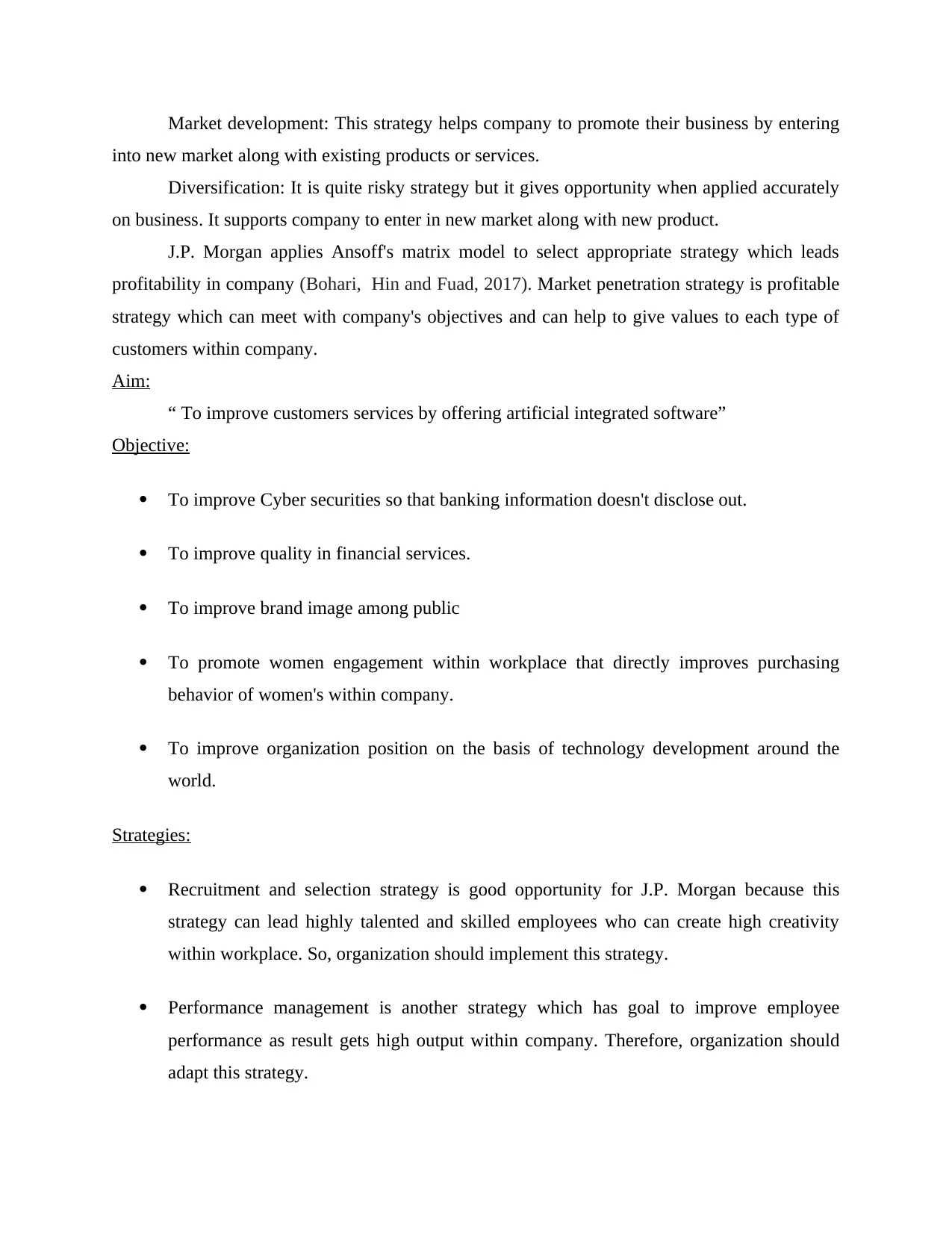
Market development: This strategy helps company to promote their business by entering
into new market along with existing products or services.
Diversification: It is quite risky strategy but it gives opportunity when applied accurately
on business. It supports company to enter in new market along with new product.
J.P. Morgan applies Ansoff's matrix model to select appropriate strategy which leads
profitability in company (Bohari, Hin and Fuad, 2017). Market penetration strategy is profitable
strategy which can meet with company's objectives and can help to give values to each type of
customers within company.
Aim:
“ To improve customers services by offering artificial integrated software”
Objective:
To improve Cyber securities so that banking information doesn't disclose out.
To improve quality in financial services.
To improve brand image among public
To promote women engagement within workplace that directly improves purchasing
behavior of women's within company.
To improve organization position on the basis of technology development around the
world.
Strategies:
Recruitment and selection strategy is good opportunity for J.P. Morgan because this
strategy can lead highly talented and skilled employees who can create high creativity
within workplace. So, organization should implement this strategy.
Performance management is another strategy which has goal to improve employee
performance as result gets high output within company. Therefore, organization should
adapt this strategy.
into new market along with existing products or services.
Diversification: It is quite risky strategy but it gives opportunity when applied accurately
on business. It supports company to enter in new market along with new product.
J.P. Morgan applies Ansoff's matrix model to select appropriate strategy which leads
profitability in company (Bohari, Hin and Fuad, 2017). Market penetration strategy is profitable
strategy which can meet with company's objectives and can help to give values to each type of
customers within company.
Aim:
“ To improve customers services by offering artificial integrated software”
Objective:
To improve Cyber securities so that banking information doesn't disclose out.
To improve quality in financial services.
To improve brand image among public
To promote women engagement within workplace that directly improves purchasing
behavior of women's within company.
To improve organization position on the basis of technology development around the
world.
Strategies:
Recruitment and selection strategy is good opportunity for J.P. Morgan because this
strategy can lead highly talented and skilled employees who can create high creativity
within workplace. So, organization should implement this strategy.
Performance management is another strategy which has goal to improve employee
performance as result gets high output within company. Therefore, organization should
adapt this strategy.
Paraphrase This Document
Need a fresh take? Get an instant paraphrase of this document with our AI Paraphraser
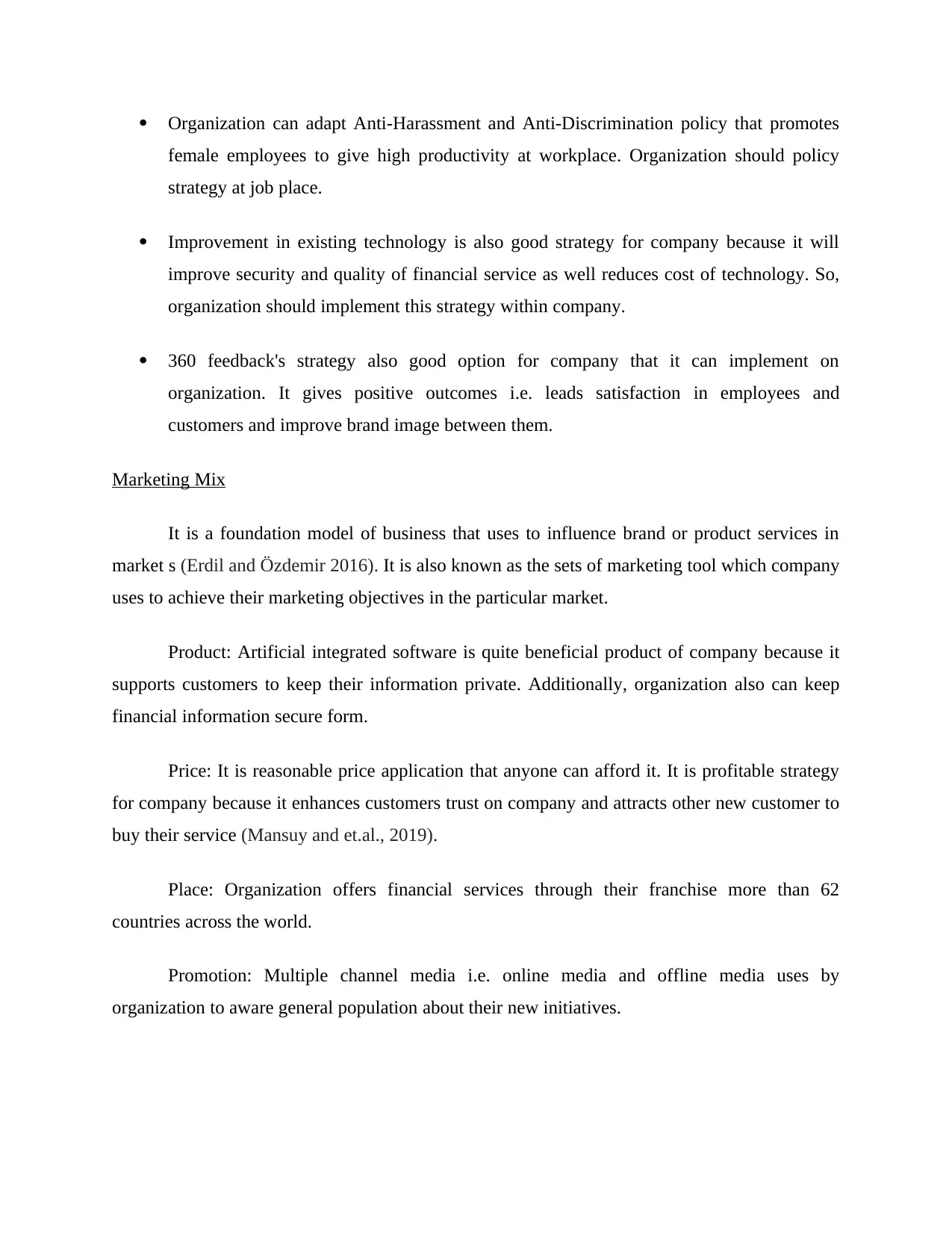
Organization can adapt Anti-Harassment and Anti-Discrimination policy that promotes
female employees to give high productivity at workplace. Organization should policy
strategy at job place.
Improvement in existing technology is also good strategy for company because it will
improve security and quality of financial service as well reduces cost of technology. So,
organization should implement this strategy within company.
360 feedback's strategy also good option for company that it can implement on
organization. It gives positive outcomes i.e. leads satisfaction in employees and
customers and improve brand image between them.
Marketing Mix
It is a foundation model of business that uses to influence brand or product services in
market s (Erdil and Özdemir 2016). It is also known as the sets of marketing tool which company
uses to achieve their marketing objectives in the particular market.
Product: Artificial integrated software is quite beneficial product of company because it
supports customers to keep their information private. Additionally, organization also can keep
financial information secure form.
Price: It is reasonable price application that anyone can afford it. It is profitable strategy
for company because it enhances customers trust on company and attracts other new customer to
buy their service (Mansuy and et.al., 2019).
Place: Organization offers financial services through their franchise more than 62
countries across the world.
Promotion: Multiple channel media i.e. online media and offline media uses by
organization to aware general population about their new initiatives.
female employees to give high productivity at workplace. Organization should policy
strategy at job place.
Improvement in existing technology is also good strategy for company because it will
improve security and quality of financial service as well reduces cost of technology. So,
organization should implement this strategy within company.
360 feedback's strategy also good option for company that it can implement on
organization. It gives positive outcomes i.e. leads satisfaction in employees and
customers and improve brand image between them.
Marketing Mix
It is a foundation model of business that uses to influence brand or product services in
market s (Erdil and Özdemir 2016). It is also known as the sets of marketing tool which company
uses to achieve their marketing objectives in the particular market.
Product: Artificial integrated software is quite beneficial product of company because it
supports customers to keep their information private. Additionally, organization also can keep
financial information secure form.
Price: It is reasonable price application that anyone can afford it. It is profitable strategy
for company because it enhances customers trust on company and attracts other new customer to
buy their service (Mansuy and et.al., 2019).
Place: Organization offers financial services through their franchise more than 62
countries across the world.
Promotion: Multiple channel media i.e. online media and offline media uses by
organization to aware general population about their new initiatives.
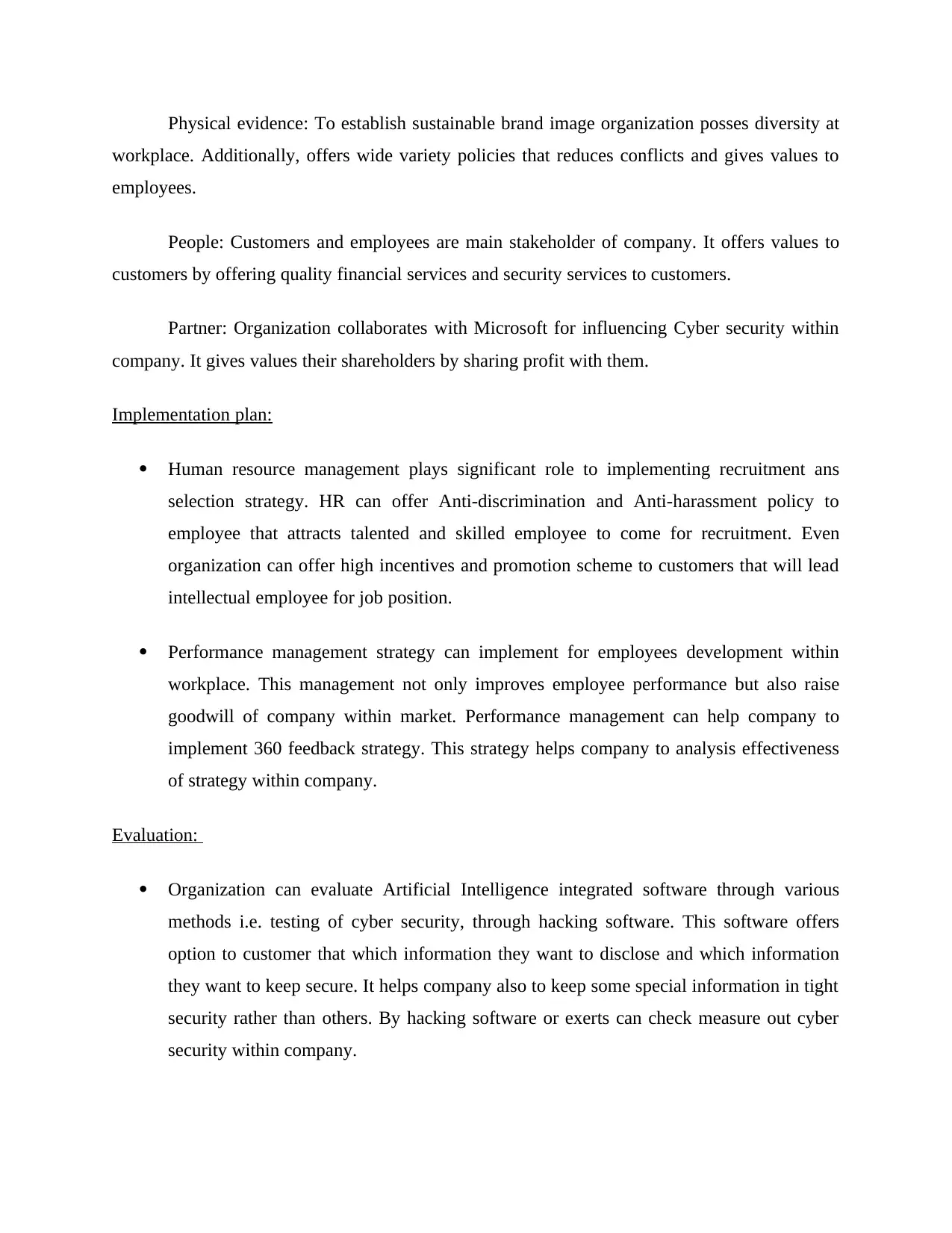
Physical evidence: To establish sustainable brand image organization posses diversity at
workplace. Additionally, offers wide variety policies that reduces conflicts and gives values to
employees.
People: Customers and employees are main stakeholder of company. It offers values to
customers by offering quality financial services and security services to customers.
Partner: Organization collaborates with Microsoft for influencing Cyber security within
company. It gives values their shareholders by sharing profit with them.
Implementation plan:
Human resource management plays significant role to implementing recruitment ans
selection strategy. HR can offer Anti-discrimination and Anti-harassment policy to
employee that attracts talented and skilled employee to come for recruitment. Even
organization can offer high incentives and promotion scheme to customers that will lead
intellectual employee for job position.
Performance management strategy can implement for employees development within
workplace. This management not only improves employee performance but also raise
goodwill of company within market. Performance management can help company to
implement 360 feedback strategy. This strategy helps company to analysis effectiveness
of strategy within company.
Evaluation:
Organization can evaluate Artificial Intelligence integrated software through various
methods i.e. testing of cyber security, through hacking software. This software offers
option to customer that which information they want to disclose and which information
they want to keep secure. It helps company also to keep some special information in tight
security rather than others. By hacking software or exerts can check measure out cyber
security within company.
workplace. Additionally, offers wide variety policies that reduces conflicts and gives values to
employees.
People: Customers and employees are main stakeholder of company. It offers values to
customers by offering quality financial services and security services to customers.
Partner: Organization collaborates with Microsoft for influencing Cyber security within
company. It gives values their shareholders by sharing profit with them.
Implementation plan:
Human resource management plays significant role to implementing recruitment ans
selection strategy. HR can offer Anti-discrimination and Anti-harassment policy to
employee that attracts talented and skilled employee to come for recruitment. Even
organization can offer high incentives and promotion scheme to customers that will lead
intellectual employee for job position.
Performance management strategy can implement for employees development within
workplace. This management not only improves employee performance but also raise
goodwill of company within market. Performance management can help company to
implement 360 feedback strategy. This strategy helps company to analysis effectiveness
of strategy within company.
Evaluation:
Organization can evaluate Artificial Intelligence integrated software through various
methods i.e. testing of cyber security, through hacking software. This software offers
option to customer that which information they want to disclose and which information
they want to keep secure. It helps company also to keep some special information in tight
security rather than others. By hacking software or exerts can check measure out cyber
security within company.
⊘ This is a preview!⊘
Do you want full access?
Subscribe today to unlock all pages.

Trusted by 1+ million students worldwide
1 out of 15
Related Documents
Your All-in-One AI-Powered Toolkit for Academic Success.
+13062052269
info@desklib.com
Available 24*7 on WhatsApp / Email
![[object Object]](/_next/static/media/star-bottom.7253800d.svg)
Unlock your academic potential
Copyright © 2020–2025 A2Z Services. All Rights Reserved. Developed and managed by ZUCOL.





